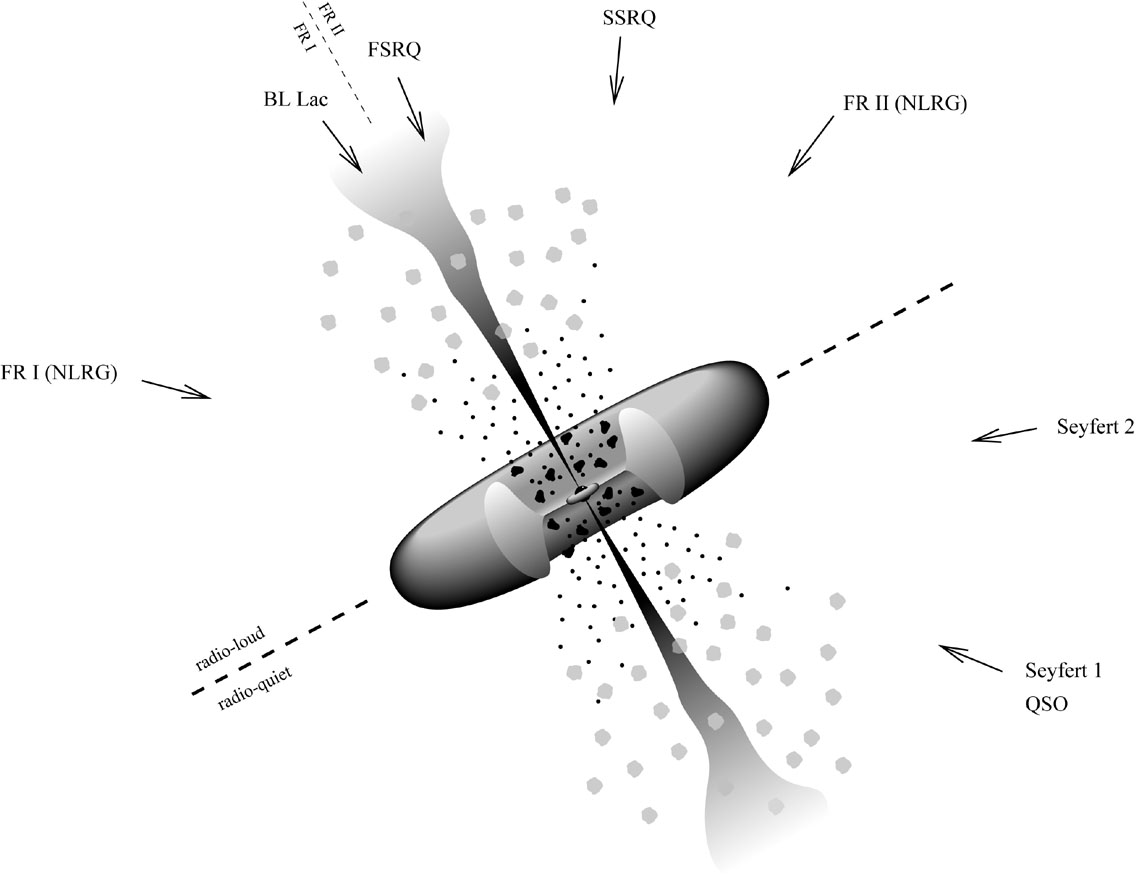Is there any evidence that the Milky Way could have been a quasar in it's early history? Is it thought that most galaxies come from quasars?
-
4$\begingroup$ Well, I don't know the answer, which is why I asked the question. Seemed like it had enough support and research. $\endgroup$– StuCommented Feb 18, 2014 at 15:55
-
1$\begingroup$ See also physics.stackexchange.com/questions/197585/…. $\endgroup$– HDE 226868 ♦Commented Aug 5, 2015 at 16:19
2 Answers
A quasar is simply an active galactic nucleus (AGN) that is viewed from a particular angle; see the picture below, in which quasars are labeled "QSO". This is really a remarkable figure because historically all of the names in the figure were thought to correspond to different types of objects, when really they all refer to the same thing! 
Your question really shouldn't be "Was there ever a quasar in the Milky Way?", since the dotted line in the figure would correspond to the Galactic plane and we would not see Sagittarius A* (the Milky Way's super-massive black hole) from the correct angle. A better question might be, "Has Sagittarius (Sgr) A* ever been active?" The answer to that question is yes; according to this page it was probably active (very bright with a jet) about 10,000 years ago. However, at the moment, it isn't really doing anything, since it isn't currently accreting anything (to put it plainly, it isn't eating anything, so it doesn't have enough energy to be active). However, many astronomers (myself included!) are anxiously waiting for a cloud of gas called G2 to fall into Sgr A*. We are hoping that Sgr A* will burp or do something interesting.
-
$\begingroup$ Awesome image. I haven't seen that one before and puts the various types of AGNs together well. $\endgroup$– CarlCommented Feb 14, 2014 at 9:25
-
$\begingroup$ Nice answer! But if you claim my answer as incorrect, so please show in which way it is incorrect, or just drop that claim. I can't see that fundamental difference, just a different focus. $\endgroup$– GeraldCommented Feb 14, 2014 at 11:29
-
$\begingroup$ Yeah, for some reason I remember reading something in your answer that I didn't like, but looking at it again it seems mostly okay. There are a few details that are still inaccurate: black holes do not form by accretion, although they do grow into SMBH's that way; if the jet points towards earth, it is a blazar (BL Lac or FSRQ), not a quasar; your answer somewhat confuses a quasar state with an active state. $\endgroup$ Commented Feb 14, 2014 at 21:34
-
$\begingroup$ Thanks! I've been inaccurate in some detail, that's accepted. $\endgroup$– GeraldCommented Feb 15, 2014 at 1:13
-
3$\begingroup$ Actually, I think the question "Has the Milky Way gone through a quasar phase?" is a fine question to ask. You claim that a mere 10,000 years separates us in time from it being considered an AGN. Fine, but AGN can be incredibly violent. Surely there must be remnants from this phase left behind for us to see - especially since the Sun is about 27,000 lightyears from the center of the MW. I'm not sure I believe your claim (which is not a claim which your source makes). $\endgroup$– astromaxCommented Feb 24, 2014 at 5:57
Quasars are thought to be active galactic nuclei. The Milky Way contains a very dense region in its center, probably a supermassive black hole.
Such a dense region or black hole is thought to form by accretion of dust, gas and stars. This accretion process of a supermassive black hole releases huge amounts of energy emitted perpendicular to the accretion disk. If such a jet at the center of a distant galaxy points towards Earth we may see it as quasar.
Hence the answer is most likely yes, the Milky Way or some of its predecessor galaxies will probably have had quasars at their centers, at some period when consuming lot of material, and seen from appropriate direction.
Most galaxies are thought to contain a supermassive black hole at their center. Therefore the same applies to most galaxies.
Here two nice simulations:
-
$\begingroup$ Hmm, I'm not so sure about your answer. I think the quasar phase of galaxies only occurs when you get major merging events - e.g. - two spiral galaxies coming together to form an elliptical galaxy. The fact that the Milky Way galaxy is not an elliptical may mean that it hasn't yet gone through this phase. It perhaps will one day when Andromeda and the Milky Way coalesce. I could also be very wrong about this. This is just from what I recall. I'll see if there are any papers on the end products of the quasar phase of galaxies. $\endgroup$– astromaxCommented Feb 7, 2014 at 0:10
-
$\begingroup$ In Milky Way we should find several supermassive black holes, if they wouldn't have merged already from predecessor galaxies. Fusion of galaxies needs not lead to elliptic galaxies, as far as I can retrieve from the simulations. They should have occured rather frequently in the first few billion years of the universe. $\endgroup$– GeraldCommented Feb 7, 2014 at 1:04
-
$\begingroup$ -1 Because the Galaxy does have a SMBH in the centre, as proven by ESO/NACO. -1 (If I could) because the outcome of a major merger does depend on the amount of available cold gas. Further -1 Because cold gas does not necessarily come from major mergers. $\endgroup$– astabadaCommented Feb 14, 2014 at 9:45
-
-
$\begingroup$ I wanted to be kind of ironic. Hope you are not offended, in which case I apologize :) $\endgroup$– astabadaCommented Feb 18, 2014 at 17:41